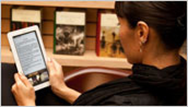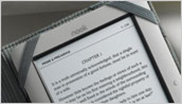Note: Go here for B&N’s Nook details and here for the media kit, including images. Also see Techmeme roundup with earlier stories. – D.R.
 Do you want to run Android apps and a good Web browser on the Nook, the new e-reader from Barnes & Noble? Then speak up in our comments section.
Do you want to run Android apps and a good Web browser on the Nook, the new e-reader from Barnes & Noble? Then speak up in our comments section.
“We haven’t announced anything regarding putting out an SDK or putting out a developer environment,” said William J. Lynch, president of Barnes & Noble.com. But he said B&N would be open to this if enough customers wanted it. Why not oblige him?
 Here is what else TeleRead picked up from Lynch’s teleconference with news organizations this morning:
Here is what else TeleRead picked up from Lynch’s teleconference with news organizations this morning:
–Web browsing or lack thereof: “There’s no browser on the Nook today. Could we have one in the future? Sure, we’re looking at all kinds of different feature sets for our road map…What people want to do primarily with these devices is read….Should…consumers…identify that as something in their reader, we’ll include it.” So share your opinions, and I’ll make sure that B&N sees them.
 –Browsing at stores: Shoppers at B&N’s physical stores, as I understand it, will be able to browse entire books.
–Browsing at stores: Shoppers at B&N’s physical stores, as I understand it, will be able to browse entire books.
–Geo limits: Owners of the Nook will apparently be out of luck if they’re traveling outside the U.S. and want to buy a book, or at least the geo-protected variety. On the positive side, you can use the WiFi from home and other locations in the States to shop for books, not just the physical stores. The Nook also comes with 3G AT&T wireless access.
–PDFs: “We will be rendering PDFs without need for conversion…natively..using use Adobe rendering technology” to achieve “crisp easy reading.” Significantly, B&N will be switching to the ePub format—which is better than PDFs, as I see it, for small screens.
–DRMing of books: “Some are encrypted and others are not…Most of our salable titles are encrypted.”
 –On book loans from user to user: After the two week loan period, the book returns to the owner. That’s right—one-user-at-a-time access. Also, authors and publishers can choose not to let their books be loaned. Most books, however, will be loanable.
–On book loans from user to user: After the two week loan period, the book returns to the owner. That’s right—one-user-at-a-time access. Also, authors and publishers can choose not to let their books be loaned. Most books, however, will be loanable.
–Annotations and last-page read syncing: They’ll happen not just on the Nook but also other platforms. Lynch may have mentioned that as a possibility for the loaner feature—I’m not sure. Great news if it happens!
–eReader compatibility: “If it’s readible on eReader softaree, there’s a good chance it will be able to be read on the Nook.” Old .pdb files should be readable. B&N is double-checking format-compatibility.
–Lack of text to speech: “We don’t think the technology works well today.” Ah, but on my Kindle it works well enough, and it’s great when driving and exercising—in order to continue what I read the old-fashioned way. In the past I’ve had problems even understanding the TTS from other systems. Lack of TTS in the Nook is a big mistake, as I see it. Only a minority of users feel this way. But I think this will change as more people catch on.
–Vs. the Kindle: “…The color touch screen makes the navigation easier. You can get get to your content more easily.”
–Sales expectations: “We won’t give any (sales) projections because it’s so early.” No profit projections at this time either.
–E vs. P sales: Lynch expects E to be “less than five percent” of B&N sales “for the next few year.” But he does intend for his company to be the largest seller of digital content” in the world.
–No discounting of the Nook price: “We’re not discounting this devicie at all. It’s $259 for everyone.” Not even discounts from B&N memberships, alas.
–Where the Nook is made: “It’s somewhere in Asia. We don’t disclose strategic supplier relationships.”
–Touch technology used on the 3.5-inch color screen, located under the six-inch E Ink display: “Capacity touch,” the same technology used in the iPhone. “There is a keyboard you can pull up and operate if you’re searching for books…”
–Newspaper and magazines: “In total we’ve got 45 newspapers and magazines at launch and we’ll be adding more weekly.” They include the Wall Street Journal, New York Times, Forbes, Newsweek and the New Yorker, among others.” In some cases B&N is setting prices; in others, publishers will.
–Advertising: Potentially in the future. I suspect it would look great on the color screen, which can already display book covers. Let’s just hope it isn’t intrusive.
–RSS feed capability: Not now. Blogs, by the way, might be added in the future.
–Buyable endings: “Consumers” will be able in the future to “purchase alternative endings” for certain books.
–Pricing: No short-term plans to standardize pricing between the big B&N e-book store and Fictionwise. Possible in the future.
While we’re on the topic of the Nook, let me note that I’m delighted to see the next-page and previous-page buttons off to the sidein the center of the Nook—not just placed at the bottom,
Related: Paul Biba’s opinions (some I agree with, some I don’t—usual, since we haven’t party lines) and


































What I have not seen yet is folders or collections, or any serious library navigation options.
With a micro-SD card, B&N claims you can hold 17,500 ebooks on a Nook. Are we really expected to swipe through them 5 book covers at a time?
… you can use the WiFi from home and other locations in the States to shop for books …
I asked him this exact question at the press conference and he said No, the WiFi will only work in a B&N store.
I wonder which answer is correct.
@Paul: During all of the Nook coverage yesterday the one thing that stood out was “wifi in store only at launch”. That seems like a fairly substantial limitation. I assume it means that we won’t be able to connect to an application like Calibre to manage our libraries. It’s also seems to be an indication that, despite a slightly more open approach to DRM, B&N is attempting to tether the device to its own marketplace.
Kirk, actually there will be WiFi at home, as I understand it–although full offerings (browsing of whole books) won’t be available. I’d hope this would be true at launch, but maybe not. Will follow up at B&N.
Alas, yes, B&N wants the device to be usable only with its own store (although I assume you can pick up stuff bought elsewhere if/when the formats/DRM permits).
Thanks,
David
The biggest problem with this device is that its screen is too small.
Most of the books you can “find” are PDFs with page sizes close to letter size.
These won’t be readable on the device.
You need to be able to put pirated stuff onto the divece to make it worth (see iPods) – sad but true.
and that won’t work without a large enough screen.
A good part of the reason that I would want a 3G-enabled e-book device is to be able to browse the web with it as well as read books. (Like the webcomic said.) No web browser = no sale for me.
I also hope we’ll be able to shut the LCD part off when we’re reading a book. Powering a color LCD all the time would suck down battery power and negate a large part of the e-ink battery advantage.
And I hope we’ll be able to download stuff directly from the eReader and Fictionwise stores as well as the B&N the way we can with eReader on the iPhone.
As a Java programmer considering doing the Android thing, I definitely want an SDK.
Probably not. A dedicated ereader should do one thing well: display text. It doesn’t need not email or internet or whatnot. Sure, I like the Wikipedia option on the Kindle, but have only used it once or twice, and full browsing capability is not what I want. Having the Minesweeper game is nice but droll, and it would be ultimately distracting to have a vast array of different games available.
Basically, the Nook eReader, Kindle, et al shouldn’t be imitating the iPhone or other multipurpose devices, let them be just readers.
There is great potential surrounding the ability to construct Android applications for e-Readers such as the B&N ‘Nook’. Many interesting applications could be provided for this platform: semantic linkages between book and Internet-based content, automatic tagging and other navigation strategies for purchased e-Books, etc.
@Tamas: If the screen were “too small” I don’t think they’d get 45 newspapers and magazines onboard at launch.
I read PDFs with Evince on the screen of the EeePC 701, and its screen would seem to be smaller than the Nook screen.
The idea that PDFs won’t be readable if they have letter-size pages isn’t my experience. Screen size is only one contributor to readability. Contrast is another and one that plays to E-ink’s advantage.
“You need to be able to put pirated stuff onto the divece to make it worth (see iPods)”
iPods aren’t worth it unless they store pirated content? I don’t think you’ll find much support for that notion.
@Tamas Simon: Not really a concern for me, but the “items” (to continue the theme of evil quotes) I have seen were ideal for reflow. Heck, it is easy enough to copy-paste the text in those documents to convert to HTML or other formats, if desired.
I was really excited yesterday, but today I’m coming to realize that I’m more excited by the potential of a company finally understanding the consumer (which, even here, isn’t likely) rather than the short list of promises so far.
@Pep: Maybe not now, but remember iPods were introduced quite some time before Apple started selling music, back in the day when the majority of MP3 content was pirated. (Granted, there was legitimate CD ripping going on, too, but let’s not fool ourselves that this was where the majority of stuff played on iPods came from.)
Likewise, as that other story today says, 95% of the e-books that are pirated can’t be legitimately bought. But people who want to read them in e will download them anyway, and they’ll want to read them in the way most convenient for them.
I don’t understand why wifi is a selling point for this device. Is that an admission that the AT&T data link won’t be that good? And if there is no web browser who cares?
As a programmer, I think that enabling a wider base of devices to buy applications is always beneficial for the brand owning the device.
Apple open that path and all major mobile manufacturers are struggling to achieve their results two years later… and probably nobody will make it in two more years.
Just top of my mind, I see myself selling library-management applications with advanced filtering and sorting, WiFi and 3G management applications, an application to make or sell characters’ tracking diagrams (very useful for Life and Destiny, from Vasily Grossman) and support for multillingual dictionaries during the reading (let’s say Latin for The name of the Rose, Umberto Ecco).
About the point that “an e-reader just should do one thing”: well, there are many ones like this, as there are many mobile phones without camera or tactile screen.
An SDK for making applications for the device will be a great leapfrog and an strategic advantage for B&N.
“Do you want to run Android apps and a good Web browser on the Nook, the new e-reader from Barnes & Noble?”
YES YES YES. I can’t say that enough.
“Do you want to run Android apps and a good Web browser on the Nook, the new e-reader from Barnes & Noble?”
YES YES YES. I can’t say that enough.
And YES again.
BTW, sure web 2.0 might be all about interactivity but good olde worlde web 1.0 was about reading. Like what I just did with your article – I read it. It would be nice to read it on the Nook.
I’ve been on the fence for ebook readers and the Nook pushed me over the edge. Handled right (i.e. not locked down too much) I think this could be the tipping point for ebooks (hey, perhaps that’s why they’re giving away that book?)
The lending feature is key. I have no problems with the 14 day limit or the one person at a time. As long as I can re-lend it to the same person actually having my books come home to me after a set period of time I’ve lent them out is a bonus. One person at a time is reasonable – puts it on par with paper. Will there be a limit on the number of times the book can be lent? Can we set up lending circles? I sure hope so…
Is it November 30th yet? Or December 5th or whenever my Nook will sail in through the door…
I AGREE WITH BEN! GET US A WORKING WEB BROWSER! Barnes and Noble would be foolish to not put a vital part of the Kindle’s success into it’s own e-reader!
Ok for B&N to kill Kindle they need the following:
-Word Doc Reader, duh! Bus + Mac + Students = Would Use this
-Application platform (Licensing to iPhone’s iTunes would be the best market bet, but if too expensive, android is a close second)
-Email book segments/quotes (great for share readers or students writing a book review/research paper. Especially if you want students/scholars to read articles and newspapers.)
-Make sharing as easy as email and text (sign up phone number and email accounts like a cell phone)
-Employ a Google search for the eBook collection on the eReader
-Awesome Text-To-Speech Voices!!!!! So many college students would use this when they are traveling to and from school on holidays
-Wifi on airplanes
-A graduate MIS intern working on their eCommerce, eBook, digital education, mobile applications, etc. to provide priceless usability and adoptability feedback
I would love to see web browsing functionality on the Nook, it would make it a crossover to the tablet world!
“Do you want to run Android apps and a good Web browser on the Nook, the new e-reader from Barnes & Noble?”
YES! YES! YES!
1. Android- if Nook doesn’t include text-to-speech, I want the freedom to add it. If Nook has no foldering software or Google-like search feature for my book collection, I want the freedom to add it.
2. No browser? No sale. (Can eliminate this with #1 above.)
3. Locked-down WiFi? No sale. (I already have free-of-charge WiFi available in my home and many other places, and a Verizon service account for my smartphone; I’m not buying another account from another provider.)
Sure we need a full SDK for this device – and standard Java for Android would be fine.
At least the ability to use it as a webbrowser would be nice.
I would like an SDK for the Nook. I am the director of an assessment analysis and generation tool. I would like to see the Nook used in classrooms as assessment tools. A school could buy 30 Nooks and teachers could check them out and use them for their classes to take assessments on the Nook. The data would use http to upload to the analysis database for grading and analysis.
I have a nook and I’d love to see a web browser added on to future firmware. A developer kit would be an excellent touch as well, but the addition of the web browser would let me check email/social networks/school sites extending the use of the device extensively.
I really desire to have a web browser. Avid readers like to explore the context of what they are reading, so it only makes sense that a browser would be built-in to an eReader. Reading Franz Kafka? Launch the browser to read up on the historical context, bibliography, literary interpretations and more. Readers are interested in absorbing information, the Internet provides expansion on the reading experience. Besides, I think Barnes & Noble should remain competitive with Amazon’s Kindle.
I own a Nook and a Kindle(trying to decide between the two), and would love to see the same features for wireless capability on the Nook in future firmware updates as are included in the Kindle, including web browser and ability to buy books while overseas.
Please publish an SDK, if you want to compete with Apple, this would help.
As a nook owner/programmer/engineer I find this news very exciting. My PDF datasheets can be read in the nook now but I have no ability to zoom in on images and tables. PDF rendering has comething to be desired An SDK will be a welcomed addition. I’m very anxious to improve upon the existing PDF reader and add some nook HW. B&N have a lot to gain from the opensource community.
I love my nook, and I would love to get my hands on an SDK for it.
“Do you want to run Android apps and a good Web browser on the Nook, the new e-reader from Barnes & Noble?”
Yes, that would be great because then it would allow the Nook to do a lot more. Make sure it works on all Nooks.